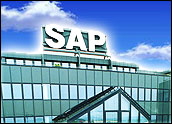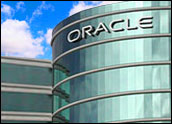
OK, so here we are a week later and what do we know for sure? Well, lots of things. First, Oracle now has seven assorted CRM packages from its acquisitions and those of its acquired companies — if you count Siebel. The issue with counting Siebel is that the deal is not done yet. Don’t look for the shareholders to derail this one since many have been clamoring for greater returns on their investments for quite a while. And don’t look to the SEC to stop this one either. Unlike Peoplesoft, Siebel wants to be acquired, so the whole process should go much faster.
Meanwhile there are several factors which, deal or not, stand in the way of Oracle becoming the most dominant force in the enterprise software industry. Among them are the competition, Oracle’s increasingly decrepit business model, and time. By far, look to Oracle’s business model to weigh down the company.
The Model
Oracle started life on the mini-computer. Its claim to fame was its ability to run on just about anything that had silicone and drew power from a socket. Last week in San Francisco, I was joking with some analysts and reporters about what a big deal Oracle for VAX-VMS was. When the mini-computers and their makers went to the bone yard, Oracle continued humming away by introducing tools and financial applications as it embraced client server computing.
In many ways client server was an easy evolutionary shift for the database giant because some organizations simply continued using their mini-computers with PC networks. Initially, many users simply used the PCs in emulation mode (i.e. like dumb terminals) as they gradually converted to more sophisticated applications.
So the point now is that Oracle continues to look like a client server application provider despite advances in the Web orientation of its database and the fact that even companies like Salesforce.com run their hosted services on top of Oracle databases. But by buying up so many leading client server application companies and vowing to make it all work together, Oracle has cemented itself into a paradigm that is on the way out. Moreover, the vow to make it all work is a distraction from what should be the work of leading software vendors like Oracle — to usher in the age of the utility model for enterprise computing.
It was said a lot last week but it may bear repeating: In its present form Oracle looks a lot like a later-day Computer Associates gobbling up healthy but troubled or sun-setting applications companies with a plan to capture the maintenance revenue. In my view, there is something almost biblically foolhardy about trying to capture market share by buying up your competition, sort of like trying to bail out New Orleans with a sieve.
Time and Competition
There has been a lot of talk about 2007 and 2008 recently. Microsoft said that their converged products will hit the market some time that year, and now Oracle is forecasting great and wonderful things beginning to hit the market two years hence. The trouble is that markets don’t stand still and there are a lot of existing and emerging competitors out there that can use the intervening time to tell a more coherent story and grab a lot of market share, especially from defecting Oracle customers who want stability or who may not want to put all their delicate eggs into the Oracle basket.
SAP for one stands to be a big winner from the Oracle mashup. This company already has tens of thousands of customers and is further along in the quest for a fully integrated front to back enterprise business application suite. Then there are the on-demand vendors like Salesforce.com, NetSuite, and a long list of others that want to move into the space. Last week in San Francisco, Salesforce.com made a big splash with an announcement that pits it squarely against Oracle, SAP and all the other companies still selling a modified client-server suite.
And for different reasons, Salesforce.com has also positioned itself in direct competition with Microsoft (and later Oracle) for the databases and tools that enterprises use to fire up a simple tracking application for small groups, for example. Think of it. There hasn’t been an improvement on the basic idea of using PC databases and tools to develop small applications since Intel was numbering its chip families. While databases and tools were a vast improvement on spreadsheets and index cards, they were hardly intuitive for a business user. And when the apps were done, they didn’t always feed into the corporate data repository.
The on-demand model offers orders of magnitude lower costs which make it immediately attractive at the enterprise level and the latest announcements from Salesforce.com indicate that a community of secondary providers, also known as partners, is growing up around the service. The result will be an accelerated build-out of additional applications such that the on-demand service will be able to rival anything that comes to market in, say, 2007.
The Road Ahead
So Oracle has some work ahead of it. Oracle has created a new category of software which I have heard called “instant legacy” meaning that regardless of the product plans and futures of acquired applications, with Oracle at the helm, it’s a new ball game. The ideas of fusion and long-term support for the acquired applications are really separate, not part of a continuum. To do fusion in a two year time frame means that a lot of redundant code will be left out. And as a practical matter, it only makes sense. If Oracle has seven sales force automation products, they will mostly overlap so six are redundant. That means the Siebel products will most likely be the ones that dominate whether it’s in SFA, marketing or call center.
As for the installed customer base — the real prize Oracle was shooting for — when it’s time to look for the next generation of business applications, smart buyers will still perform their due diligence and Oracle will very likely be invited to propose. But that seems a rather small return for the billions invested in the takeovers. That’s why I say that the company should have innovated its way to the next generation rather than buying up competition it might have defeated in the field anyhow.
Denis Pombriant is a well known thought leader in CRM and the founder and managing principal of the Beagle Research Group, a CRM market research firm and consultancy. Pombriant’s latest white paper, Adding Sales to the Call Center Agenda, summarizes his recent research in the call center industry. In 2003, CRM Magazine named Pombriant one of the most influential executives in the CRM industry. Pombriant is currently working on a book to be published next year. He can be reached at [email protected]

























































